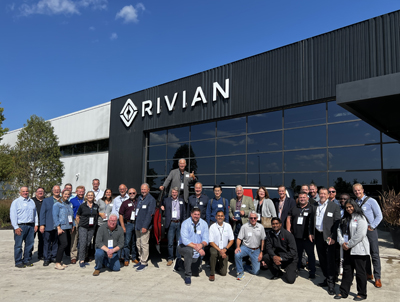EV Charging Infrastructure
Rivian’s assembly line is similar. There are two lines, one for passenger vehicles and another for the EDV, so Rivian can interchange the R1S and the R1T.
In addition, Rivian has created a recycling program to recondition its batteries.
“Recycling is a great opportunity,” he said. “When an EV battery reaches its end of life, there's still a tremendous amount of life and capability in that battery. It doesn’t just need to be thrown away.”
As the industry moves away from internal combustion engine (ICE) vehicles to battery electric vehicles (BEVs), Phillips foresees charging networks will help drive adoption rates across all EV product lines.
“I absolutely love Rivians,” said Phillips, who owns an R1T and an R1S. “They're fantastic vehicles, but I will confirm… I have charged at Electrify America chargers and others and have been very frustrated.”
Phillips said the recent adoption of the North American Charging Standard (NACS) chargers designed by Tesla will help address infrastructure challenges and lead to more rapidly available and reliable charging.
“Manufacturers are working on solutions to deliver robust, high-powered charging locations nationally and each OEM has a branded strategy to address the gaps,” he added.
Phillips talked about Rivian’s role in contributing to the charging infrastructure. As a new vehicle company, Phillips said the charging network is something leadership understood needed to be addressed to succeed.

“The scope of our company ethos is to keep the world adventurous,” he noted. “When you take your Rivian out on the trail, we want to have a charging network there for you to access.”
In addition to a wall charger and portable charger, Rivian is building the Rivian Adventure Network, a comprehensive network of fast-charging sites, initially capable of adding up to 140 miles of range in 20 minutes to the R1T and R1S. Open to Rivian owners, the network is planned to grow to more than 3,500 fast chargers at over 600 sites across the U.S. and Canada.
Rivian is also collaborating with Tesla to charge its vehicles at more than 12,000 Tesla Superchargers across the U.S. and Canada with an NACS adapter.
Although Phillips said the transition to EVs is an adventure, he encourages repairers and customers to stay positive while the charging infrastructure is implemented.
Rivian Certified Collision Network
When Phillips joined Rivian three years ago, he was tasked with creating a certified collision network across North America with Kelly Logan, Rivian’s director of collision. The first body shop was certified in August 2021; there are now 220 certified locations. They are comprised of four programs under the Rivian Certified Collision Network umbrella: Rivian Certified Collision Centers (RCCC) locations working on R1 products, Rivian Certified Fleet Center (RCFC) locations working on the commercial vans, RCDC locations offering calibration and diagnostics, and RCV locations, B2B partners working with Rivian on predelivery repair needs.
The Rivian collision team is in the field recruiting shops and working with repairers to help them perform better. Each program is designed to address specific customer needs, which Phillips said allows the network to focus on vehicle specialization.
“Flexible program offerings ensure a better customer experience by placing clients in the right locations to start,” he said. “Offering choice also adds appeal to the program by addressing program entry costs.”
Phillips said one of Rivian’s unique features is the manufacturer’s certified diagnostic and calibration program, created to ensure a successful calibration and safe and proper repairs.
“When you look at a Rivian, there are cameras and sensors everywhere so it is going to need calibration if it’s in an accident,” he said.
Since Rivian opened its doors, Phillips said the company is happy with its progress.
“The quality of the Rivian continues to ramp up and improve and they are a treasure to drive,” he said. “Our customers are saying the same.”










Stacey Phillips Ronak